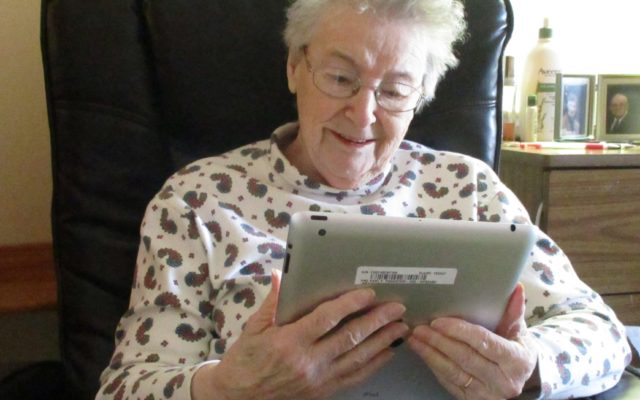
Long-term health care residents stay connected to loved ones through donated iPads
Self-distancing and other stay-healthy-at-home mandates in response to the COVID-19 pandemic have made for an unusual level of isolation, even for the most outgoing Mainers.
But consider the lot of those additionally isolated by declining health, particularly those residing in the state’s nursing homes.
Perhaps equal in importance to the medical lifeline provided by their caretakers are their links to family members and other loved ones.
Those latter relationships have been challenged since the state’s nursing homes have been closed off to visitors in virtually all circumstances until further notice in an effort to protect facilities’ more vulnerable residents from the spread of the coronavirus.
That presents just one more challenge for nursing home administrators as they seek to address their residents’ emotional needs as well as their physical health issues.
At the Hibbard Skilled Nursing & Rehabilitation Center in Dover-Foxcroft, that effort has been bolstered by the recent receipt of two iPad 4 tablets from The Commons, a multigenerational, community-based organization located in the Piscataquis County shiretown.
The Commons also donated a third laptop to the Hilltop Manor assisted-living facility in Dover-Foxcroft after purchasing the iPads with a grant from the Harvard Pilgrim Healthcare Foundation.
“I was just heartbroken at the thought of older people, who already often experience the sadness and fear of living away from loved ones and their community, now being unable to have in-person visits,” said Dr. Lesley Fernow, president of The Commons’ board of directors. “I thought we had to do something to improve their lives and the lives of their families during this unpredictable and stressful time.”
The laptops already have provided an additional means of connection between Hibbard residents and their families.
“We have to try to provide a lot of different options for families because some are more technologically comfortable than others,” said Hibbard administrator Aaron Thomas. “Some people have become very comfortable doing a Zoom visit or FaceTime with their family members because as of five or six weeks now they haven’t been able to come in since the governor’s announcement.”
Hibbard staff work with families in advance to set up times for the internet visits, with a staff person dedicated for those organizational efforts that makes these new-age visits possible.
“Usually the residents are pretty amazed by it,” Thomas said. “They’ll say ‘Oh look, there’s Kelly’s face!’ It’s new-fangled, but they don’t care. It’s been awesome to help to maintain those relationships. You just have to be creative at these times.”
Thomas estimates his facility has helped arrange two to three iPad family visits daily since receiving the laptops about two weeks ago, with face-to-face window visits remaining the most frequent meeting method.
“Honestly, we’ve probably done more of the window visits,” he said. “They’ll come and call on their phone and we’ll bring a phone to the resident and bring them either to their window or a common window, and they can have a conversation.
“One family hung a big giant heart on the gate outside of Mom’s window. We’re trying any way we can to connect the two.”
Thomas hopes to take even more advantage of the available technology to provide Zoom or FaceTime visits for residents and their loved ones.
“I’ve been a little surprised that it hasn’t been used more than it is,” he said. “If anything, it’s more the family saying, ‘I’m not good with computers,’ but we’ll certainly try to talk them through it and help them with that part. The population we care for is from a certain generation, but some of our residents are ridiculously tech-savvy and some have a preference not to be.
“Everybody’s finding their new normal for the time being,” he added. “We’re just trying to help bridge that gap.”
Thomas said the iPads also may provide his facility with more tele-medicine options.
“Our medical provider is still in the building at this point,” he said. “But at this point you’re also making backup plans on top of backup plans so we’ve made all of the proper connections so with a single click he could be talking with us on Zoom.”